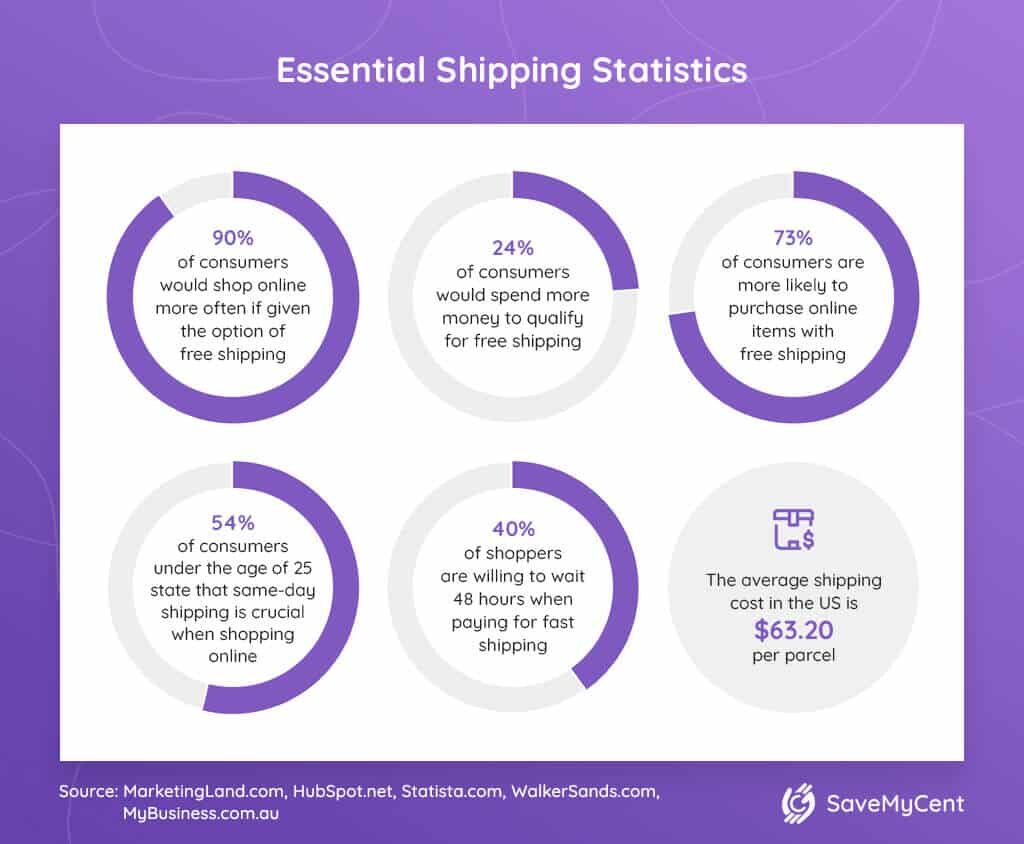With ecommerce growing steadily and retail stores gradually dying out, the competition in the online shopping business is intensifying. Free shipping is slowly but surely becoming one of the most powerful weapons in ecommerce companies’ decisive battle for consumers.
The free shipping statistics you’ll see in this article demonstrate this feature’s tremendous impact on customers’ purchasing decisions.
These stats can help your business stand out in the crowded world of ecommerce.
Top 8 Free Shipping Statistics (Editor’s Choice)
- 90% of consumers would shop online more often if given the option of free shipping.
- 24% of consumers would spend more to qualify for free shipping.
- 73% of people are more likely to decide to buy an item if it includes free shipping.
- 34.1% of young shoppers say they value discounts more than free shipping.
- Companies with free shipping have a 20% higher conversion rate than those without this option.
- 71% of products sold on eBay include free shipping.
- 78% of Amazon Prime members say they’ve signed up because of free shipping.
- The first-ever Free Shipping Day involved more than 250 companies.
General Shipping Statistics

1. 90% of consumers would shop online more often if given the option of free shipping.
(Marketing Land)
In a 2016 survey by Walker Sands, 9 out of 10 respondents said free shipping would be their main reason to shop online more frequently.
It may be difficult to believe that free shipping can have such a significant impact on buyers’ decisions. However, this finding could prove useful to companies that focus on ecommerce, especially when fighting to win over indecisive consumers.
2. 24% of consumers would spend more money to qualify for free shipping.
(HubSpot)
According to Wingify’s ecommerce statistics, offering free shipping increases companies’ chances of selling more. 28% of people will abandon their cart if they notice an unexpected shipping cost. However, if they see an option to qualify for free shipping, almost a quarter of shoppers would be willing to spend more money to take advantage of this opportunity.
3. 73% of consumers are more likely to purchase online items with free shipping.
(Statista)
No matter how you look at it, people love getting something for free, even if it’s shipping. With this in mind, it’s no surprise that almost three-quarters of consumers say they decide to buy products and services much faster if they don’t have to pay for their delivery.
4. 54% of consumers under the age of 25 state that same-day shipping is crucial when shopping online.
(Walker Sands)
The younger generations appreciate speedy delivery over free shipping, facts reveal. In a 2018 Walker Sands survey, more than half of respondents aged 18–25 said that same-day shipping for the purchased goods was the main factor in their online shopping decisions.
5. 40% of shoppers are willing to wait 48 hours when paying for fast shipping.
(Statista)
A 2019 survey asked consumers how long they were willing to wait when paying for fast delivery. According to the resulting shipping statistics, 40% of respondents stated they were ready to wait up to 2 days for delivery.
If the delivery time were to increase by just one day, this percentage would drop to 18%.
6. The average shipping cost in the US is $63.20 per parcel.
(MyBusiness)
With such a staggeringly high average shipping cost per parcel, the US is by far the most expensive country to send a package in. Next in line are:
- The Netherlands – $27.90
- France – $26.50
- Australia – $26.40
If you’re about to ship a package inside Romania, you’ll be pleased to know that the average shipping costs for online shopping in this country are just $3.65. Such a low shipping cost makes Romania the cheapest country to ship a package in.
7. 81% of consumers run online price comparisons before deciding where to buy their desired product.
(Adweek)
Before finally deciding where to buy a particular product, most consumers check its price across multiple online stores. Ecommerce facts say that 81% of consumers will look for a better offer from at least three other e-tailers before choosing where to buy this product.
To defeat the competition, ecommerce companies should consider introducing free shipping on all products. That way, even if other websites offer lower prices on some products but don’t have free shipping, buyers looking for the best deal may still choose your site.
8. There are 20 million shipping containers around the world at any moment.
(National Today)
Thanks to the development of technology and ecommerce, shipping has become a 24/7 business. As you’re reading this, there are more than 20 million shipping containers en route to hundreds of countries around the globe.
Digital Commerce Facts
9. Web-only marketplaces record 47% of all online purchases.
(Statista)
On the other hand, brand and retailer-owned websites and apps record only 18% and 26%, respectively. Given this information and general ecommerce trends, the number of companies that offer free shipping might increase in the future. This could spell disaster for smaller retail businesses with online stores that don’t generate enough revenue to offer free shipping.
10. Only 17.5% of the most prominent ecommerce companies offer free shipping on all of their products.
(Digital Commerce 360)
This means that just 175 top 1,000 ecommerce businesses offer free shipping on all purchased items. Meanwhile, free shipping stats show that another 65.4% of these companies offer some type of free shipping, either on select items or on orders that exceed a specified price threshold.
11. 55% of US consumers cite free and discounted shipping as the main reason for purchasing at an online marketplace rather than a retailer.
(UPS)
More than half of US-based respondents to a 2018 UPS global survey pointed out that, if they had to choose between online shopping without shipping charges and buying at a physical store, they would opt for the former.
57% of Mexican, 51% of Canadian, 41% of European, and 47% of Asian consumers said the same thing, proving the universal importance of free shipping on people’s buying decisions.
12. 60% of consumers would choose one online store over another due to better shipping options.
(PR Newswire)
Statistics on fast free shipping show just how important quick and easy product delivery is for overall customer satisfaction. According to PR Newswire’s research, 54% of consumers will stay loyal to ecommerce platforms offering the most convenient delivery options. On the other hand, 39% will move on to another e-tailer after just one negative shipping-related experience.
Free Shipping Statistics on Major Ecommerce Companies
13. 71% of products bought on eBay are delivered with free shipping.
(Oberlo)
According to the company representatives, this is one of their strategies to retain existing customers and attract new ones. However, this may not be ideal for sellers as they have to pay the shipping costs themselves. In addition, they pay a small fee to eBay, not just for the product they’re selling but also for shipping and handling.
To improve their bottom line without affecting the eBay free shipping statistics, some sellers decide to incorporate the shipping cost into the product price.
14. Two-day free shipping is the reason why 78% of customers signed up for Amazon Prime.
(eMarketer, Ordoro)
Although Amazon Prime provides access to hundreds of popular movies and TV shows, millions of songs, and thousands of free books, the vast majority of users signed up for the service because it offers two-day free shipping on all orders.
Consumers are always looking for new ways to make additional savings, and this further proves free shipping‘s massive impact on sales.
Here are some other things customers do to secure free shipping:
- Add items to cart to qualify for free shipping – 58%
- Choose the slowest shipping option because it’s free – 50%
- Search online for promo codes for free shipping – 47%
- Choose ship-to-store – 35%
15. Amazon reversed its decision to increase the free shipping threshold due to negative reactions from customers.
(The Verge)
Upon introducing two-day free shipping with Prime in 2016, Amazon decided to increase the free shipping threshold for non-Prime users. The first Amazon free shipping increase amounted to 40%, from $35 to $49. However, the company reversed its decision just months later. In May 2017, less than a year after the threshold increase, Amazon decided to further lower the free shipping threshold to $25, which is where it was before 2013 and where it currently stands.
All these changes were made because customers were unhappy with Amazon‘s initial free shipping increase, and they used the internet to voice their opinions. This shows that customers don’t like changes that negatively affect their options, especially those concerning free shipping.
16. 35$ is the minimum order to qualify for two-day free shipping on Target.
(Money Crashers)
Like Amazon Prime and Walmart Plus, Target offers two-day free shipping. However, their free shipping threshold is $35, $10 higher than Amazon’s. The company also provides numerous discounts, but many discounted items can’t be shipped and are only available in-store.
Besides Amazon and Target, the list of free shipping sites for online shopping includes the following:
- Walmart (orders over $35)
- Brandless (orders over $48)
- Nordstrom (items under 5lbs)
- J.Crew (select orders; loyalty members only)
- Madewell (loyalty members only)
- Everlane (orders over $75)
- Zappos.com (all orders)
17. 25% of sellers on Etsy added a free shipping option to rank better in searches.
(EcommerceBytes)
According to EcommerceBytes’ 2019 free shipping statistics, a quarter of Etsy sellers stated that they decided to include free shipping in their offer to increase their visibility in searches on this popular website.
However, the results of this move were twofold. On the one hand, some claim that adding free shipping has resulted in increased sales. On the other hand, the cost of adding this option to their offer has eaten away a portion of their revenue.
More Fascinating Free Shipping Stats
18. Free shipping serves as a crucial marketing tool for 60% of retailers.
(Mageplaza)
Companies continuously come up with new ways to try to attract more consumers. One of the many benefits of free shipping comes in the form of increasing one’s sales.
According to numerous surveys, free shipping also increases the company’s competitiveness and lowers the chances of shopping cart abandonment. On that note, a 2017 report from Transportation Insight revealed that 60% of potential buyers who leave their shopping carts before completing a purchase do so because of high shipping costs.
19. Adding the free shipping option can help increase your store’s conversion rate by as much as 20%.
(Ometrics)
A case study conducted by Ometrics revealed that all you have to do to increase your store’s free shipping conversion rate is to highlight the words “Free Shipping” in a visible place on your website. The researchers also ran a few experiments and concluded that writing these words in red seems more effective than using any other color.
20. 50% of big-name ecommerce orders in 2015 were shipped with no charge.
(Invesp, The Wall Street Journal)
These free shipping ecommerce statistics refer to the 30 biggest online shopping platforms in the United States. According to The Wall Street Journal, that’s a sizable increase from 33% in 2013.
Although more recent data isn’t available, it’s safe to assume that this number is significantly higher today, especially after the introduction of free two-day shipping by the likes of Target and Amazon Prime.
21. 250+ merchants participated in the first-ever Free Shipping Day.
(MarTech Advisor)
The Free Shipping Day was created in 2008 in an attempt to extend the online shopping season beyond the Black Friday and Cyber Monday sales. The event saw more than 250 major participants in its first year, and earnings amounted to over $764 million.
Among the first Free Shipping Day participants were companies like Target, JCPenney, Pottery Barn, and many others.
22. 34.1% of young consumers prefer discounts over free shipping.
(Wiser)
That’s not to say there aren’t those who consider free shipping more important. Including respondents between the ages of 25 and 34, this free shipping vs. discount survey from Flagship Research found that 18.5% of them value free shipping more than discounts when shopping on ecommerce platforms.
Free Shipping – Does It Save Money or Is It a Mere Marketing Tool?
From a consumer perspective, the advantages of free shipping are obvious.
If we find one product in multiple places, all offering approximately the same price but only one offering free shipping, we’ll choose the one with free shipping.
A single glance at these free shipping statistics will help you see how much impact this feature can have on your company’s revenue and customer satisfaction rates.
Yes, to afford free shipping, your business will have to make certain financial sacrifices or increase prices to make up for the loss. But if you implement it the right way, free shipping can significantly boost your traffic and, as a result, increase your sales.
FAQ
How does free shipping work?
To attract as many customers as possible and boost their sales, ecommerce companies include free shipping in their offer. Some platforms send all items free of charge, while others have certain conditions customers must meet to be eligible for this benefit.
For example, while Zappos.com offers free shipping on all orders delivered to the US, Amazon will only ship your order for free if it exceeds $25 in value. For Target, the minimum price threshold is $35. There are also companies that offer free shipping for a limited time only (e.g., during the holiday season) and those that only have it available for specific products.
How do you get free shipping?
Depending on the platform you’re buying from, you may have to meet the minimum price threshold or buy specific products to qualify for free shipping. Some websites offer free shipping on all orders, so you don’t have to worry about meeting the minimum dollar value.
Every year in December, hundreds of online stores participate in the Free Shipping Day. Buying on that day is another good way to secure free shipping, especially on larger purchases. Finally, some stores also accept coupons and discount codes for free shipping.
Is free shipping really free?
Although platforms may advertise free shipping, somebody still has to pay for the shipping cost. Sometimes it’s paid for by the seller, as advertised. In many cases, however, buyers pay for it.
Some major ecommerce companies generate enough revenue to afford free shipping. A good example of one such company is Amazon, which doesn’t only have its retail business but is also involved in publishing, moviemaking, and providing cloud storage services. However, some small retailers can’t afford free shipping, but many of them still decide to offer this feature while increasing their products’ prices a little to protect their bottom line.
Is free shipping important?
Free shipping has become a crucial marketing tool for many ecommerce businesses. It helps them attract new customers, retain existing customers, increase their sales, and ultimately remain competitive in the overcrowded online shopping market.
Ecommerce statistics clearly speak in favor of free shipping. For example, one survey found that 71% of consumers are more likely to buy items if they come with free shipping. Another similar survey showed that 55% of American consumers would buy a product online rather than going to a physical store to purchase it as long as they could have it delivered to their door for free.
Does free shipping increase sales?
Research suggests that free shipping may be a good incentive for indecisive consumers, but it doesn’t necessarily mean they’ll make the purchase if they haven’t yet decided to do it. On the other hand, if a customer is willing to buy something, offering free shipping could be enough to seal the deal.
According to research, 90% of consumers would buy online more often if given the option of free shipping. More importantly, 24% of consumers would even be willing to spend a little more money than planned to qualify for free shipping, which some platforms are taking advantage of by introducing minimum free shipping thresholds.
How important is free shipping to consumers?
Studies show that people are more inclined to buy from websites with the “Free Shipping” label displayed prominently. This is rooted in human psychology – we all like to get things for free, even if it’s free shipping on a product we’ve paid for.
Furthermore, many consumers tend to compare prices across multiple online stores before deciding where to buy. If a product is similarly priced in all the stores, they’ll always opt for the one with free shipping. That’s because free shipping reduces the total cost of their purchase. Even though consumers are always on the lookout for quality products, money is often the critical factor in their buying decisions.
Why do companies offer free shipping?
Companies offer free shipping mostly for marketing but also to build and expand their customer base. One of the main reasons lies in the simple fact that customers don’t like to pay for anything other than the price of the product they’re buying.
In fact, free shipping statistics reveal that 28% of all consumers abandon their shopping cart whenever they see an unexpected shipping cost. Because they want to retain their customers’ trust and turn them into loyal shoppers, companies choose to offer free shipping.
Sources:







![How to Get Free Clothes From Shein? [2024 Guide]](https://savemycent.com/wp-content/uploads/2023/09/How-to-Get-Free-Clothes-From-Shein-336x220.png)
